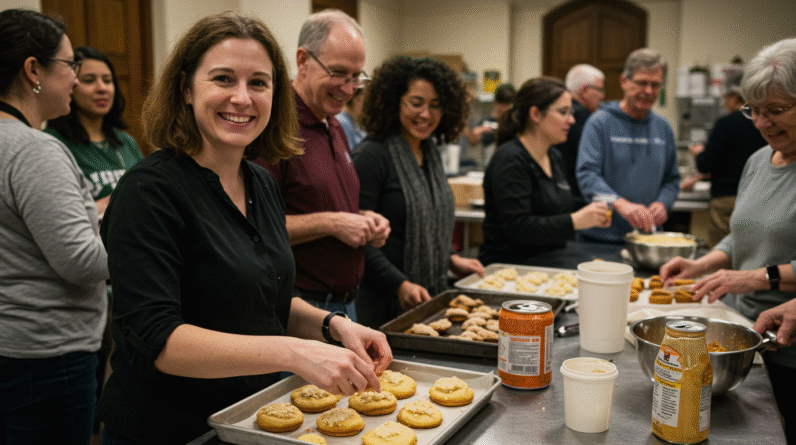Ruth’s Faithful Service To Naomi — A Story Of Love And Loyalty
You’re standing at the doorway of an ancient story that still speaks to the heart. Ruth’s story is one of loyalty, sacrifice, and everyday holiness. It’s not just a tale from long ago; it’s a mirror that shows how faith becomes visible in how you treat other people. In this article, you’ll explore Ruth’s faithful service to Naomi in Ruth 1, discover practical principles for your life, and understand how genuine service flows from loyalty and faith. Along the way, you’ll see the scripture that shapes the story and how to apply it today.
Why this story matters to you
You might think Ruth is primarily a romance story or a genealogical footnote in the Bible. But when you pause in Ruth 1, you discover a spiritual portrait: how faith and loyalty combine to create acts of service that change lives. You’ll find that Ruth serving Naomi means not an ancient abstraction — it’s a pattern for real-life discipleship. You’ll learn how loyalty and faith produce practical care, how grief and hope can coexist, and how your own commitments can reshape someone else’s future.

The setting: hardship, choice, and return
To understand Ruth’s faithful service, you have to start with context. The book opens with a family in crisis: famine, migration, and the death of the husband and sons. This sets up the painful but crucial decision that follows. Ruth and Naomi are foreigners in a foreign land, vulnerable and uncertain. The choice about where to go and whom to cling to is not only cultural — it is moral and spiritual.
You can read the opening scene that frames the story in Ruth 1:1-5. It tells of Elimelek, Naomi, and their two sons leaving Bethlehem because of famine, and later the deaths that leave Naomi bereaved and childless. This is the backdrop of grief against which the profound act of service will be displayed.
Naomi’s heart and the turning point
Naomi’s reaction to her losses is raw and honest. She decides to return to Bethlehem after hearing that the famine has ended. When she makes that decision, an opportunity for loyalty appears — and a test of character for both of her daughters-in-law. Naomi’s plan to go home signals a new chapter where faith, memory, and identity are all in play.
Read the scripture that marks Naomi’s decision in Ruth 1:6. Naomi’s move back to Bethlehem is a turning point where loyalty will be revealed. You’ll notice how, in moments of transition, true character is often exposed.
The test of loyalty: choices at the crossroads
When Naomi encourages her daughters-in-law to return to their own homes, she is freeing them to choose safety and new marriages. This is a loving, even sacrificial, act on Naomi’s part — she knows the invitations of home and family in Moab might be better for them than following her to a bitter life. Orpah chooses to go, but Ruth makes a different decision.
Naomi’s words to them are captured in Ruth 1:8-9. You’ll see Naomi’s humility and realism in how she releases them. This moment exposes the heart: will they prioritize their comfort or respond to loyalty?
Ruth’s defining pledge
The defining moment comes when Ruth refuses to leave Naomi. Her words are among the most quoted in Scripture because they express covenant-level commitment. Ruth does not simply promise to stay physically; she pledges to share Naomi’s fate, adopt her people, and worship her God. That pledge is the hinge of the whole book and the demonstration of what genuine service looks like.
You can read Ruth’s pledge in Ruth 1:16-17. Those verses show the depth of Ruth’s attachment. When you meditate on them, you’ll see that Ruth serving Naomi meaning goes beyond duty — it’s a whole-life commitment rooted in love and faith.
What Ruth’s decision teaches about loyalty
At its core, Ruth’s choice is about loyalty. You should notice three qualities of that loyalty: it is voluntary, costly, and transformative. Ruth chooses to leave her homeland, language, and family hopes. She chooses economic insecurity and social vulnerability. Yet she chooses worship and relationship over convenience.
When you consider Ruth serving Naomi meaning, remember that loyalty isn’t sentimental. It’s practical. It means walking into another person’s pain and staying there. It means making choices that risk your comfort for someone else’s benefit. That kind of loyalty is rare, but it’s exactly what reshapes families, communities, and churches.
Loyalty as a spiritual act
You might think of loyalty as an emotion, but in Scripture, it is a spiritual act. Ruth’s pledge ties her to Naomi’s God and to Naomi’s people. That spiritual dimension is critical: service without faith is charity at best; service grounded in faith is worship. Ruth did not merely fill a practical need — she embodied a new identity.
Reflect on how Ruth serving Naomi meaning includes adopting Naomi’s God. Ruth’s decision to walk with Naomi toward Bethlehem is also a decision to move toward Yahweh’s people and promises. When you serve in faith, your service becomes part of your spiritual witness.
The practical expressions of Ruth’s service
Service often looks mundane. In Ruth 2 and beyond, Ruth demonstrates practical service by gleaning in fields, working, and showing respect for Naomi’s dignity. But Ruth 1 is where the commitment gets made. You’ll see that faithful service begins with a decision, then is lived out in daily deeds.
Even in the opening chapter, Ruth’s action reorders priorities. Her service is not showy; it’s consistent. When you think about the daily ways you can serve others — small gestures, reliable presence, steady work — you are following Ruth’s example.
How grief and loyalty interact
Naomi responds to loss with a bitterness she does not hide. She renames herself Mara — “bitter” — and questions the Lord’s dealings. That reaction is honest and human. Ruth doesn’t correct Naomi’s grief; she honors it. That is a powerful lesson: service honors the reality of pain even as it brings presence and hope.
You can read Naomi’s confession in Ruth 1:20-21. Naomi’s words remind you that service is not about fixing emotions quickly; it’s about walking with someone through their bitterness, patiently and faithfully.
Ruth serving Naomi meaning: what it looked like in action
When you unpack Ruth serving Naomi meaning, you discover an interplay between loyalty, sacrifice, and faith. Ruth’s loyalty led to sacrifice — leaving her country, securing scarce food — and that sacrifice was an act of faith in God’s providence. You should see how these elements relate: service motivated by faith is both costly and redemptive.
Ruth’s service demonstrates that faith is relational. Her commitment brought tangible change to Naomi’s life and eventually to the community. The book later shows how Ruth’s faith and loyalty lead to inclusion in the lineage of David — but it all begins in Ruth 1 with that faithful pledge.
The cost and reward of faithful service
You might be tempted to think that serving others guarantees immediate reward. Ruth’s story reminds you that faithful service often begins in obscurity and hardship. Rewards can be delayed or take unexpected forms. But Scripture also makes clear that God honors faithfulness. Ruth’s commitment, though costly, set in motion a redemptive chain that touched generations.
Think about practical application: when you serve, prepare for hard work and uncertain outcomes, but also expect God to work through your faithfulness. Ruth serving Naomi meaning contains this dual reality — service costs, and it blesses.
How Naomi’s bitterness was transformed by the presence
Naomi starts as a bitter woman. She wanted to be called Mara and believed God had dealt harshly with her. But Ruth’s commitment did something more than provide food: it brought Naomi into a new story. Presence matters. When someone faithfully stays, they often become a conduit for healing and renewed purpose.
You can follow the narrative to the end of Ruth 1 in Ruth 1:22. The return to Bethlehem sets the scene for restoration. Ruth’s presence is a seed that will sprout into reconciliation and community redemption. When you faithfully serve, you might not see the full fruit immediately, but your presence can be the soil in which healing grows.
Presence as a ministry
Presence is more than being physically there; it’s staying emotionally and spiritually engaged. Ruth’s presence with Naomi is active, not passive. She works, listens, honors Naomi’s status, and aligns herself to Naomi’s people. That active presence is the heart of pastoral care and everyday ministry.
Ask yourself: Are you able to be present like Ruth? If not, what’s in the way? Pride, busyness, fear, or a desire for recognition? Ruth’s story teaches you that true presence requires humility and a willingness to be vulnerable alongside another person.

Misconceptions about service and loyalty
Many people have misunderstandings about what it means to serve. You might think serving means losing your own identity, or that loyalty demands total self-erasure. Ruth’s story challenges these misconceptions. While Ruth did leave her homeland, she did not lose who she was; rather, she found a new identity in covenant loyalty.
Another misconception is that loyalty is blind obedience. Ruth’s loyalty was conscious and voluntary. She knew the cost and chose to accept it. Your loyalty should likewise be chosen, not coerced, and anchored in grace, not guilt.
Service is not just doing tasks
If you equate service with tasks alone, you miss the heart of Ruth’s example. Ruth’s service was relational and covenantal. It wasn’t simply gleaning; it was aligning her life with Naomi’s. When you serve, you’re not just ticking boxes — you’re entering into someone’s story. That’s the real meaning of service.
Reflect on your motivations: are you serving for recognition, because you feel obligated, or because you want to participate in God’s kingdom work? Ruth’s model points you toward the last motive.
Practical steps to live out Ruth’s example
If you want to follow Ruth’s pattern, there are concrete steps you can take. Start by choosing relationship over convenience. Choose presence over avoidance. Be willing to make sacrifices, even small ones, that show you value another person’s well-being above your comfort.
Second, align your actions with faith. Ruth’s pledge included a commitment to Naomi’s God. Your service should be prayerful and rooted in God’s Word. Third, practice patience. Restoration and fruit often take time. Fourth, respect dignity. Ruth honored Naomi’s status and never made her a project. Lastly, work faithfully — consistent, humble labor often accomplishes more than dramatic gestures.
Simple practices you can start today
- Make a habit of visiting or calling someone who’s grieving and listen more than you talk.
- Offer practical help — prepare a meal, run an errand, help with household tasks.
- Pray with and for the person you’re serving, inviting God into the situation.
- Ask how you can help rather than assuming; dignity matters.
These steps translate Ruth serving Naomi meaning into everyday actions that transform lives.
How churches can model Ruth’s example
The local church should be the place where Ruth-like service is cultivated. Churches can encourage covenantal care networks, teach members to bear one another’s burdens, and create systems for long-term support rather than quick fixes. Training people in pastoral presence — how to listen, how to be present in grief — will create a culture where loyalty and faith are practiced daily.
You can advocate in your church for small groups committed to care, mentorship, and intergenerational relationships. Ruth serving Naomi meaning points the church points toward sacrificial relationships that look more like family than programmatic ministry.
Leadership and faithful service
Leaders should model Ruth’s humility and sacrificial presence. Leadership that seeks to serve first, rather than be served, establishes a powerful example. When leaders live out loyal, faithful service, the whole community follows.
As you consider your leadership role — whether in family, church, or workplace — ask yourself: are you cultivating loyal, sacrificial relationships, or are you opting for efficient but shallow interactions? Ruth’s story challenges leaders to choose depth.
The theological heartbeat of Ruth’s service
Underneath the human choices in Ruth 1 is God’s providence. Ruth’s loyalty becomes part of God’s redemptive plan. By serving Naomi, Ruth becomes part of a lineage that leads to King David and ultimately to Jesus. That theological axis shows you that small acts of faithfulness can have cosmic significance.
When you reflect on Ruth serving Naomi meaning, you’ll see that God often uses ordinary acts of love to accomplish extraordinary purposes. Your faithful service might seem insignificant now, but it could be part of God’s larger story.
God’s timing and human faithfulness
One of the most encouraging lessons is that God’s redemptive work often unfolds gradually. Ruth’s immediate act of loyalty does not produce instant triumph; it is the start of a process. When you are faithful, trust God with the timing. Serve faithfully even when results are invisible, because God is weaving a narrative far beyond your sight.
Personal reflections: where you fit in the story
You can place yourself in this narrative in multiple ways. Maybe you’re in the role of Naomi — hurting, tempted to withdraw, needing someone to stay. Maybe you’re in the role of Ruth — ready to step into someone else’s pain but unsure what it will cost. Or perhaps you’re a bystander, watching and wondering how to help. Each role has responsibilities and blessings.
If you’re Naomi, allow yourself to be honest about your bitterness and accept the hands that reach out. If you’re Ruth, prepare your heart for cost and for joy. If you’re a bystander, learn to follow the leadership of faithful persons and support sustainable service.
Practical reflection questions
- Who are the “Naomis” in your life or community?
- What would it cost you to be a Ruth to someone today?
- How can you align your service with faith, not just with good intentions?
These questions move you from admiration to action.
Common obstacles to faithful service
There are real barriers to living out Ruth-like service: fear of vulnerability, busyness, pride, and the desire for immediate results. You may fear being drained, misunderstood, or taken advantage of. You may feel you don’t have enough resources to help. These are real, but they are not insurmountable.
Address fear with prayer and wise boundaries. Confront busyness by reprioritizing your calendar. Combat pride by remembering that humility is the soil of service. Expect that faithful service requires risk, but also trust that God supplies what you need for obedience.
Setting healthy boundaries
Ruth’s service was sacrificial but not self-destructive. You should model wise boundaries: serve in ways that are sustainable, seek community to share the load, and maintain spiritual practices that replenish you. Healthy boundaries ensure long-term faithfulness rather than burnout.
Bringing Ruth’s example into your relationships
What does it look like to apply Ruth serving Naomi meaning in marriage, family, friendships, and ministry? In marriage, it means standing with your spouse through pain, making sacrifices, and choosing loyalty over convenience. In family, it means showing up for aging parents or for family members in crisis. In friendships, it means being a reliable presence. In ministry, it means serving people consistently and with humility.
Remember: consistency trumps charisma. Ordinary, faithful presence often accomplishes more than extraordinary efforts that are short-lived.
Small steps that lead to big change
Start with one person. Commit to a meaningful action for that person over the next six months and stick with it. That’s how cultures change. That’s how family histories are redirected. Ruth serving Naomi meaning becomes practical and powerful when you take manageable steps and sustain them.
Final encouragement: your faithful service matters
As you finish reflecting on Ruth 1, let this be your encouragement: your fidelity matters even when you don’t see the harvest. Ruth’s pledge led to inclusion in God’s redemptive lineage and demonstrated the power of love and loyalty. You may never know the full impact of your service on this side of eternity, but Scripture assures you that God notices and uses your faithfulness.
You’re invited to pledge your own — not necessarily to leave your country, but to prioritize faithful presence, sacrificial love, and spiritual commitment in the people God places in your life. When you do, you’ll be participating in a timeless pattern of redemption.
A closing prayerful word
Lord, help you choose loyalty over convenience. Choose to serve out of faith rather than duty. Choose presence over performance. Let the legacy of your faithfulness bear fruit beyond what you can imagine. Amen.
Explore More
For further reading and encouragement, check out these posts:
👉 7 Bible Verses About Faith in Hard Times
👉 Job’s Faith: What We Can Learn From His Trials
👉 How To Trust God When Everything Falls Apart
👉 Why God Allows Suffering – A Biblical Perspective
👉 Faith Over Fear: How To Stand Strong In Uncertain Seasons
👉 How To Encourage Someone Struggling With Their Faith
👉 5 Prayers for Strength When You’re Feeling Weak

📘 Jesus and the Woman Caught in Adultery – Grace and Mercy Over Judgement
A powerful retelling of John 8:1-11. This book brings to life the depth of forgiveness, mercy, and God’s unwavering love.
👉 Check it now on Amazon
As a ClickBank Affiliate, I earn from qualifying purchases.
Acknowledgment: All Bible verses referenced in this article were accessed via Bible Gateway (or Bible Hub).
“Want to explore more? Check out our latest post on Why Jesus? and discover the life-changing truth of the Gospel!”








